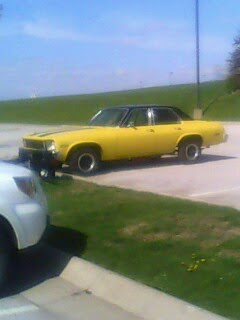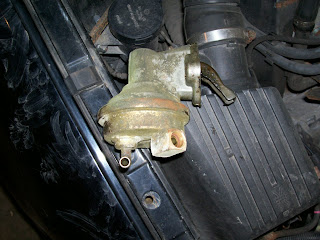So I started up my nova this year, and took her for a drive. I was disappointed when I got on it and put put put put vroom. I had a dead spot on acceleration.

First suspect was timing. But it ran fine before I parked her for winter. Timing can't just change itself. A spring can break in the vacuum advance, but the base timing can't change itself, unless you have a a major mechanical fault.
So that was ruled out I started to suspect the carb. Maybe I some how bumped the jet screws, perhaps? Not likely, I did turn them up hair just in case. I have to turn them back down now that I think about it, it is running just a hair rich.
So I had another suspect, the choke. I drove the car for five minutes, came home the engine barely read 100 degrees and the choke was wide open. Perhaps it was adjusted too lean? Opening to fast starving the poor car of the fuel it desperately needed. Later as you will find out the gauge proved unreliable
But as I sat and thought about it, I realized something, something big. Since I put the 327 in I don't know how old the fuel pump is. No idea, could be original from 1968.
While I was at it I change the fuel filter. A long time ago I took the filter out of the tank, and carb, and just use an in line filter. I have no idea what the fuel filter is for actually. I take it in when I need a new one and get a new one. I think it was for a Toyota? I don't know, I had an issue with the filters, I bought the car for 250 or so bucks because no one could figure out what was wrong with it. It was also brown and rusty, missing a back bumper, but had four new tires. So I bought the car, replaced all kinds of things, only to find out the fuel filter in the carburetor was backwards (long story). I took it out threw it away, took the "net" filter out of the tank threw it away, and ended up with my Toyota in line filter, it was just laying around anyway.

So I popped the new filter in, and installed the new fuel pump. Which is what this blog is about. The Fuel Pump. So the fuel pump is on the passenger side of the block. It is mounted with gasket, and two bolts. The pump has an arm on it which is ran by a rod inside the engine. The rod pushes down and the spring in the arm pushes the rod back up, then the rod pushes down, and so on.

This motion over a diaphragm, back and forth, works like a syphon hose kind of, to draw the gas out the tank, through the filter, and into the carb.
Steps:
Remove fuel lines
Remove bolts
Remove Fuel pump
Easier to put something in front of the pump rod inside the engine now
Scrape the old gasket off
Fit new Gasket
Pack fuel pump arm cavity with grease
Fit new fuel pump (shove rod back up if you have to)
Tighten bolts
Hook up gas line
Start and watch for leaks
So I took mine off, it looked old. A word, or note. When you pull your SBC fuel pump out get a small screw driver, piece of wire, or whatever in the hole to catch the pump rod. The rod will slide all the way down, then you have to fight to get it up and in position for the next fuel pump to fit properly.

I let my rod drop. It took me longer to get it, shove it back up, and hold it there, than the putting the new fuel pump on. Damn rod, even tried my magnetic pick up tool because I couldn't get a screw driver in front of it.
Of course you have to unhook your hoses, but the new fuel pumps have lovely lettering that states "In" from the tank, and "Out" to the carb right on them.
The biggest problem is that damn rod. The bolt are easy to get to, the gasket easy to place, and the whole job is pretty easy. But a word of warning. Your standard SBC will not have enough crankcase pressure to kick the oil up to lube the pump. Pack the arm cavity with grease before installation.

Many people will tell you this will "contaminate" the oil, but don't do it and you'll be changing the fuel pump again very soon. My old one barely had any remnants of grease left in it.
Also don't forget to scrape off your old gasket, and use a new one. If you don't' scrape it off you'll get gas spraying out everywhere. And gas is like gold, too expensive to throw away (that was lame).
Now to the electric versus mecnhanical fuel pump debate. Electric is much better, you can regulate your pressure, get better performance, and it is easier to install.
Know what? An electric fuel pump has left me stranded. They don't have to get weak first, they can just die, you can blow a fuse, and your car is DEAD until it is replaced of course.
A mechanical fuel pump has never left me stranded. They get weak, then they die. But you get notice. I like notice. Hey this is getting ready to go bad, time to change it.
I like that.

Not like our VW, which decided just not to start in parking lot one day. No grinding, no weak starts, just boom the starter dead. Would you rather have that? Or would you rather have a starter you could grind for a day or two, until you fix it?
That ends the electric versus mechanical fuel pump debate for me.
So I replaced the fuel pump. Easy job, two hoses, two bolts, and I took it for a drive. Runs excellent. I notice at this point to not trust my lying temp gauge. It rose to 100 or so degrees and froze, then jumped to 200 degrees and froze. I parked my car, and three hours later still said it was about 200. I tapped it and it fell to zero. Bad Gauge.
By the way, my car normally runs 190. 200 if I am in stop and go traffic, or sitting waiting. If I am on the highway 170 is about normal, so don't let the 200 freak you out.
So I have replaced my tach, which is another blog. But that ruled out my choke theory of opening before the engine was hot enough.
That's the story of me replacing the pump.

Tips: Lube the arm, catch that rod, and scrape the old gasket off.




There's a bolt in the front of the block. Remove it and put in a longer bolt and screw it in until it hits the rod. That bolt will hold the rod in place while you change the pump. Afterwards put a bunch of washers on that bolt and screw it in until it seats. The washers will prevent it from hitting the rod.
ReplyDeleteThanks for sharing this post. I just buy a electric pumps And the work very good.
ReplyDeleteThanks for sharing this post....but If you want to buy any petroleum Equipment, Petrodirect has a Best Fuel Equipment Suppliers
ReplyDelete